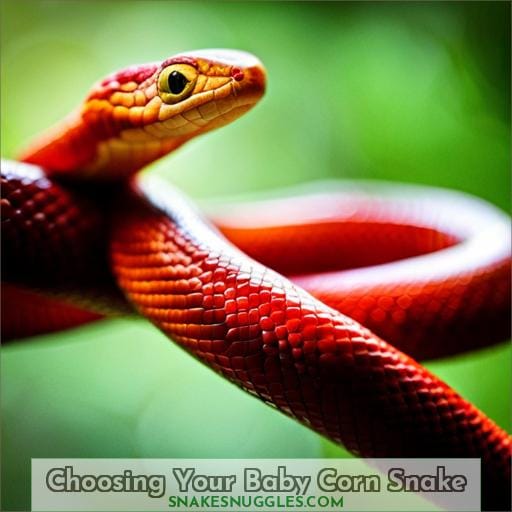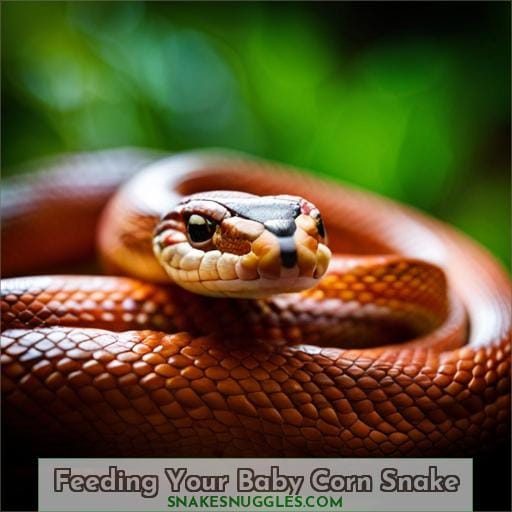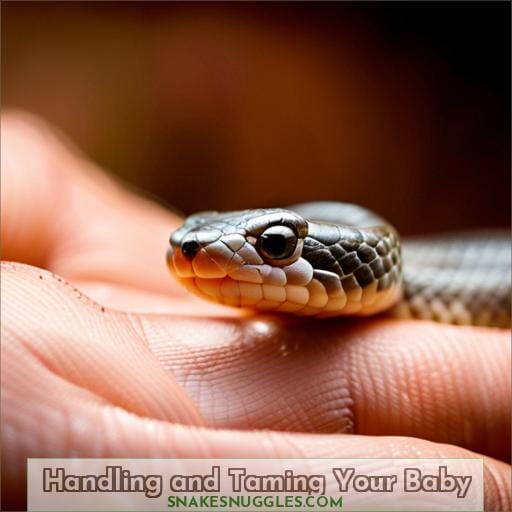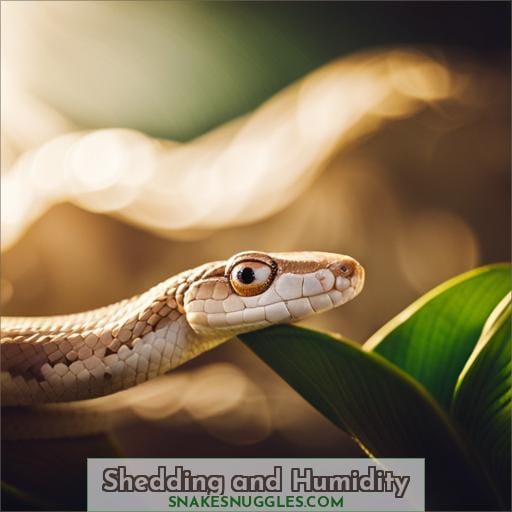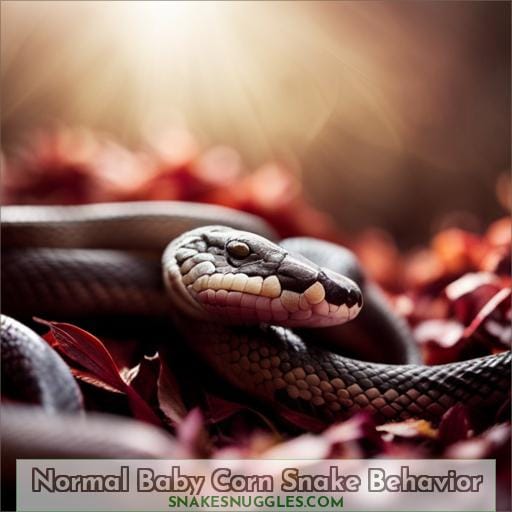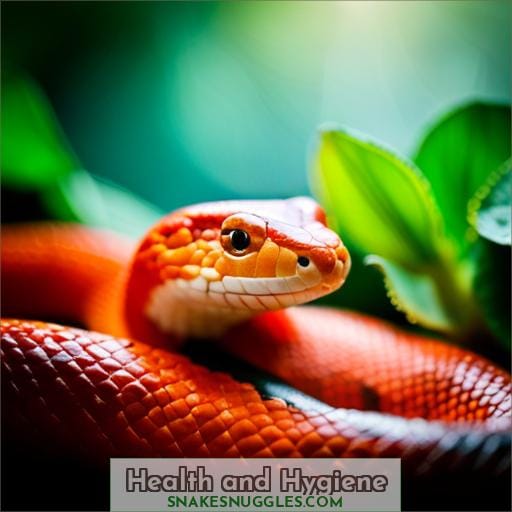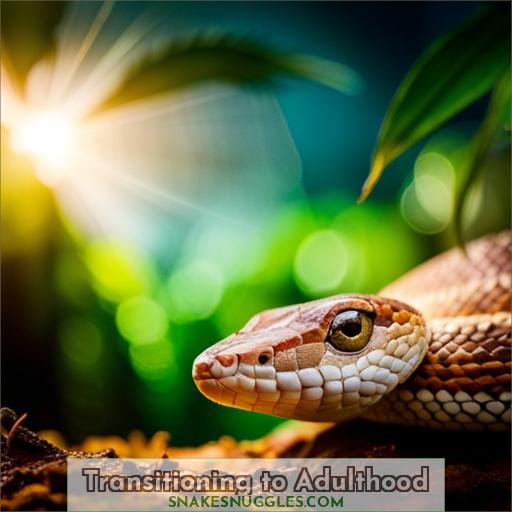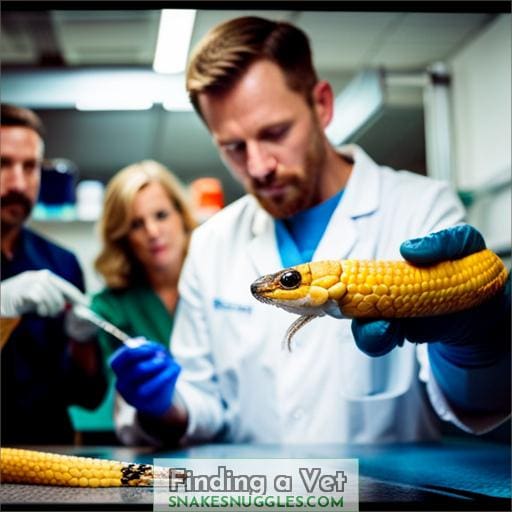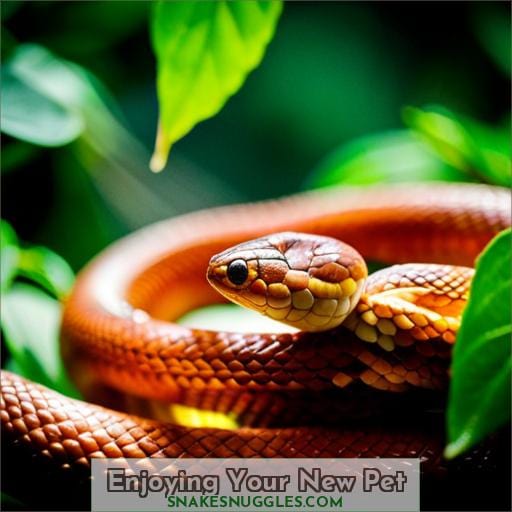This site is supported by our readers. We may earn a commission, at no cost to you, if you purchase through links.
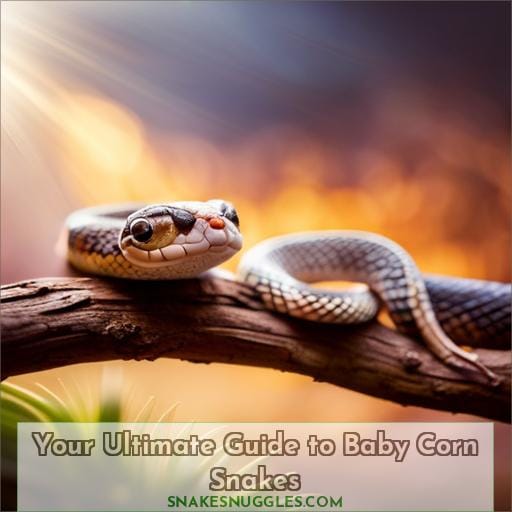 Every parent dreams of their child’s future,
Every parent dreams of their child’s future,
but nothing prepares you for the newfound joy
and endless astonishment of welcoming your first cornsnake.
Embrace the excitement of raising this precious being
from just a tiny hatchling to a magnificent adult.
This guide offers everything you need to know
to give your baby cornsnake the best life possible.
Table Of Contents
Key Takeaways
- Choose an appropriate tank size and setup proper temperature gradients for the enclosure.
- Feed an appropriately sized pinky mouse every 5-7 days at first, then increase prey size as the snake grows.
- Allow time to gently handle and tame the snake 2-3 times per week once settled in.
- Maintain proper humidity and offer a humid hide box during shedding cycles.
Choosing Your Baby Corn Snake
When choosing your baby corn snake, you’ll need to consider the morph and cost.
Different corn snake morphs have varying colors, patterns, and prices.
Make sure to research the morphs available and budget accordingly before acquiring your new pet snake.
Morphs
When selecting your baby corn snake among the various morphs available, you’ll want to consider:
- Colors and patterns that appeal to you
- Staying within your budget
There are many morphs with unique colorations, from the popular amelanistic and albino to rarer variations like lava and piedball.
Focus on affordability as well as genetic diversity when choosing baby corn snake morphs.
Cost
The cost of a baby corn snake depends on the specific morph you select.
When buying from a breeder, review their reputation.
Online marketplaces like MorphMarket list price ranges for different morphs.
Pet shop prices vary; research shop ratings.
Expect to pay $20-$300+ based on rarity of genetics and color variations.
Basic color morphs cost less than rarer morphs with striking patterns.
Setting Up the Enclosure
Now that you’ve chosen your baby corn snake, it’s time to set up the enclosure properly.
Focus on getting:
- The right sized tank
- Substrate
- Temperature gradient
- Hides
Ensure your snake’s health and happiness.
Follow the guidelines carefully to create a safe and enriching habitat.
Tank Size
Where should you house your baby corn snake?
For hatchlings, start with a 10-20 gallon tank with adequate heating, substrate, hides, and decor for a healthy start.
Increase enclosure size over time as the snake grows.
Maintain cleanliness.
Substrate
You’ll want a substrate of aspen shavings about 2-3 inches deep for your baby corn snake’s enclosure.
This allows for burrowing and provides insulation while helping maintain proper humidity levels.
Spot clean and replace soiled substrate regularly.
Temperature
For temperature regulation in your baby corn snake’s enclosure, you’ll need to set up a temperature gradient:
- Warm end: 88-92°F
- Cool end: 75-82°F
Use heating pads or lamps controlled by a thermostat to achieve these temperatures.
Monitor temperatures with a thermometer to ensure they are within the desired range.
Hides
You’ll also need to provide several hides for your baby corn snake’s enclosure to help it feel secure.
Offer hides on both the warm and cool sides so it can thermoregulate properly.
Use DIY options like cardboard tubes or plastic containers with entry holes cut into them.
The hides allow your pet to feel safe while also providing enrichment.
Feeding Your Baby Corn Snake
When feeding your baby corn snake, it’s crucial to offer an appropriately sized meal at the right frequency.
To start, feed one pinky mouse every 5-7 days while monitoring your snake’s weight and body condition.
As your snake grows, gradually increase the size of the prey items.
Meal Frequency
When raising your baby corn snake, it is recommended to feed it once every 5-7 days to start.
This routine allows for proper digestion between meals while providing nutrients for healthy growth.
As the snake matures, gradually increase the feeding frequency, observing its development and adjusting the variety of prey appropriately.
Always handle the animal gently, especially after feeding when defensive instincts are heightened.
These careful feeding and handling techniques promote your pet’s well-being.
Prey Size
As your baby corn snake grows, you’ll want to gradually increase the size of its prey.
Start with pinky mice or fuzzy rats.
Upgrade to hopper mice, adult mice, and eventually small adult rats as needed to match the thickness of the snake’s body.
Always handle prey properly and monitor your snake’s health.
Handling and Taming Your Baby
- Five tips can help you gently handle and tame your baby corn snake.
- Start with short, 5-10 minute handling sessions 2-3 times per week to build trust without stressing your snake.
- Always support its body fully and avoid sudden movements.
- Handling after shedding or feeding may provoke biting, so wait a few days.
- Consider using feeding tongs when offering food to train your snake not to associate your scent with meals.
- Take care not to pull away if bitten, as this can harm its jaws.
- With time and patience, regular gentle handling helps socialize baby corn snakes into docile, handleable pets.
Shedding and Humidity
You’ll need to provide extra moisture when your baby snake starts shedding its skin.
Raise the humidity in the enclosure to between 50-60% to aid the molting process and skin renewal.
Offer a humid hide containing damp sphagnum moss that allows the baby corn snake to self-regulate.
Avoid handling the snake during shedding as this is a vulnerable time.
Maintain appropriate humidity levels between sheds.
Monitor the feeding schedule and provide supplements to support healthy shedding.
Be prepared with humidity knowledge to support the snake through its life stages.
Normal Baby Corn Snake Behavior
Its typical behaviors as a young snake include being shy yet curious as it explores its new environment.
As hatchlings, baby corn snakes tend to be quite shy due to their small size and lack of security. This shyness can lead to defensive behaviors like playful strikes if they feel threatened.
However, once settled into their enclosure and handled gently over time, they become more relaxed and confident.
When providing proper housing, temperatures, nutrition, and handling technique, baby corn snakes make for delightful pets that become increasingly interactive as understanding of their needs and typical baby behaviors grows.
Health and Hygiene
Having covered normal behaviors, it’s vital to also monitor your corn snake’s health.
Maintaining proper humidity prevents stuck sheds by providing a moist hide box.
Additionally, frequently wash hands and sanitize surfaces in the habitat to prevent bacterial or fungal issues.
Monitor temperatures daily, ensuring the gradient allows your snake to self-regulate.
During shedding, increase humidity while avoiding full-tank soaking.
Ultimately, strong preventative care through cleanliness, attention to diet, hydration, and supplements will lead to a healthy baby corn snake that brings enjoyment for years to come.
Transitioning to Adulthood
- As your baby corn snake grows into an adult, you’ll need to adjust its environment and care routine to meet its changing needs.
Expect maturing behaviors like increased activity levels and territorial attitudes.
Be prepared for growth challenges like more frequent skin shedding.
Adjust the feeding schedule to account for hormonal changes influencing appetite.
Offer an adult diet with more nutritional supplements to support good health through their 12-15 year life span.
Expand the enclosure size to give your adult corn snake more space to roam around.
Overall, the key is tuning your care practices to match each stage of growth in order to raise a healthy and happy corn snake.
Finding a Vet
You’ll want to locate an exotic pet veterinarian to provide care for your baby corn snake by the time it reaches adulthood, ensuring it has access to proper medical attention throughout its life.
A caring, gentle manner with reptiles
Experience with snakes specifically
Preventative care protocols
Capability to address emergencies
Flexible hours and scheduling
Finding the right exotic veterinarian ensures your corn snake receives appropriate wellness exams, diagnostics, and treatment if health issues emerge.
Establishing a relationship early on provides continuity of care as your snake transitions to an adult.
Select a knowledgeable vet you trust to partner in maintaining your pet’s health and longevity.
Enjoying Your New Pet
With your baby corn snake settled in, it’s time to sit back and enjoy your new pet’s antics.
Spend time simply observing your corn snake’s natural behaviors, like climbing, burrowing, and tongue flicking.
Gently handle your snake frequently to form a bond – try feeding or petting by hand.
Provide branches, tunnels, and toys to enrich its habitat and encourage natural behaviors.
Watch for tongue flicks, tight coils, or hissing as signs your snake is stressed or frightened during play.
Avoid overhandling or forcing interaction.
Remember that each snake has its own personality – be patient and attentive as you get to know your new corn snake’s cute quirks and behaviors over time.
Offer proper hydration, nutrition, and habitat enrichment to keep it healthy and happy.
Frequently Asked Questions (FAQs)
How often should I clean the enclosure?
Clean the enclosure at least once a week.
Spot clean soiled bedding daily.
Replace all aspen shavings completely every 2-3 weeks.
Disinfect the enclosure with a mild soap and water solution weekly.
This will help remove waste and prevent the growth of bacteria that could make your snake sick.
What substrate is best to use for a baby corn snake?
Using aspen shavings is best, as they mimic leaves baby corn snakes find in the wild.
At 2-3 inches deep, they allow the snake to burrow as it would naturally while absorbing waste.
Their light color also allows you to spot shed skin and waste for easy cleaning.
How can I tell if my baby corn snake is stressed or uncomfortable?
Look for hissing, sudden movements, tight coiling, disinterest in food, retreating when handled, aggression towards you or cagemates, and consistent hiding.
These are signs your baby corn may be stressed or uncomfortable.
Address any husbandry issues and give your snake time to settle in.
Is it okay to handle my baby corn snake every day?
Handle your baby corn snake sparingly at first.
Daily handling may stress the shy hatchling.
Let it settle in for a week, then handle gently twice weekly.
Slowly increase contact as you build trust.
Patience prevents forcing intimacy and reduces nips.
What signs should I watch out for if my baby corn snake stops eating?
Monitor your baby corn snake closely if it stops eating.
Check for signs of illness like lethargy, discolored scales, or discharge.
Weigh regularly to watch for weight loss.
Seek veterinary help if the snake hasn’t eaten for over 2 weeks or shows other concerning symptoms.
Getting to the root cause is key for resolving appetite issues.
Conclusion
Ultimately, your baby cornsnake depends on you for its health and happiness.
By following this comprehensive guide, you can set up the perfect enclosure, feed properly, handle gently, and look for signs of disease.
This will enable your cornsnake to thrive from a tiny hatchling into a magnificent, trusted pet.
Embracing these responsibilities fully prepares you for the joys of caring for your new baby cornsnake.

